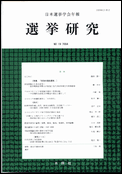Volume 36, Issue 1
Japanese Journal of Electoral Studies
Displaying 1-9 of 9 articles from this issue
- |<
- <
- 1
- >
- >|
-
2020 Volume 36 Issue 1 Pages 7-22
Published: 2020
Released on J-STAGE: November 16, 2023
Download PDF (1079K) -
2020 Volume 36 Issue 1 Pages 23-34
Published: 2020
Released on J-STAGE: November 16, 2023
Download PDF (1283K) -
2020 Volume 36 Issue 1 Pages 35-48
Published: 2020
Released on J-STAGE: November 16, 2023
Download PDF (1689K) -
2020 Volume 36 Issue 1 Pages 49-61
Published: 2020
Released on J-STAGE: November 16, 2023
Download PDF (1325K) -
2020 Volume 36 Issue 1 Pages 62-76
Published: 2020
Released on J-STAGE: November 16, 2023
Download PDF (1376K) -
2020 Volume 36 Issue 1 Pages 77-90
Published: 2020
Released on J-STAGE: November 16, 2023
Download PDF (1015K) -
2020 Volume 36 Issue 1 Pages 91-103
Published: 2020
Released on J-STAGE: November 16, 2023
Download PDF (1294K) -
2020 Volume 36 Issue 1 Pages 105-111
Published: 2020
Released on J-STAGE: November 16, 2023
Download PDF (784K) -
2020 Volume 36 Issue 1 Pages 119-
Published: 2020
Released on J-STAGE: September 12, 2022
Download PDF (754K)
- |<
- <
- 1
- >
- >|
